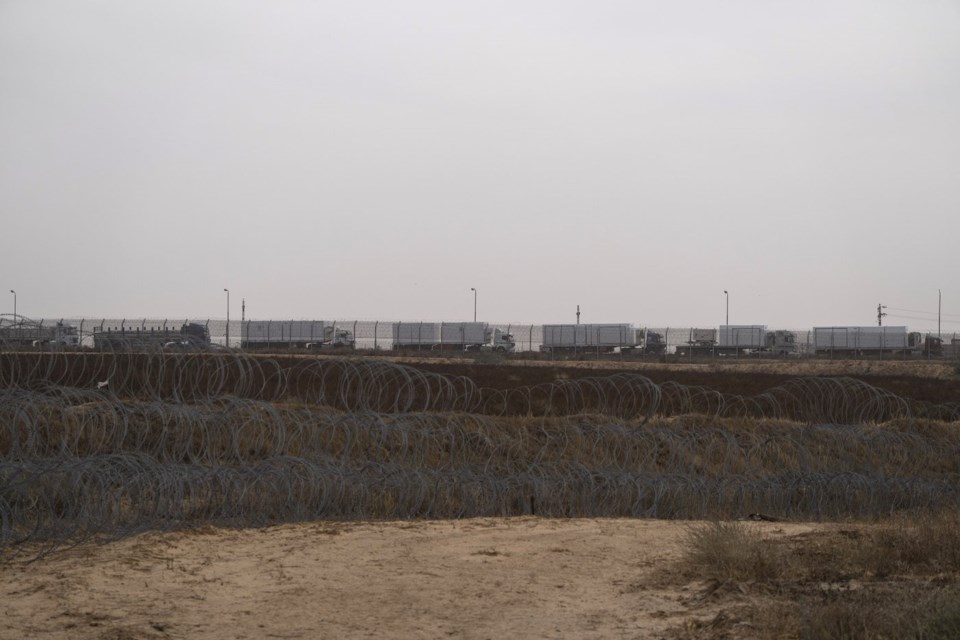KHAN YOUNIS, Gaza Strip (AP) ŌĆö An influx of aid appears to have eased a hunger crisis in northern Gaza for now, but the entire territory remains at ŌĆ£high riskŌĆØ of famine after Israel's offensive in Rafah caused displacement and the disruption of aid operations in the south, a draft report said Monday.
The report by the leading international authority on the severity of hunger crises said nearly everyone in Gaza is struggling to get enough food and that more than 495,000 people, or greater than a fifth of the population of 2.3 million, are expected to experience the highest level of starvation in the coming months.
That's despite months of U.S. pressure on Israel to do more to facilitate aid efforts, the installation of a $230 million U.S.-built pier that and repeated airdrops by multiple countries that aid agencies say are insufficient to meet vital needs.
Israel invaded Gaza after Hamas' attack on Oct. 7, in which Palestinian militants killed around 1,200 people, mostly civilians, and abducted about 250. The war has killed more than 37,000 Palestinians, according to the Gaza Health Ministry, which doesn't say how many were civilians or fighters.
Israel imposed a complete siege on the territory at the start of the war and has only gradually eased it under pressure from Washington. The war has destroyed most of Gaza's capacity to produce its own food.
The latest findings come from the Integrated Food Security Phase Classification, or IPC, an initiative first set up in 2004 during the famine in Somalia that now includes more than a dozen U.N. agencies, aid groups, governments and other bodies. The Associated Press obtained a draft of its latest report, the final version of which is set to be released Tuesday.
, in March, the IPC said that famine was ŌĆ£imminentŌĆØ in northern Gaza, which has suffered widespread destruction and which Israeli troops have surrounded and largely isolated since the earliest days of the ground invasion. That report said that around a third of Gaza's population was experiencing stage 5 hunger ŌĆö the highest level of starvation.
In April, after and sparked international outrage, Israel promised to ramp up aid, and it later opened additional land crossings in the north. The IPC said the amount of food deliveries to the north ŌĆ£sharply increased.ŌĆØ
But in early May, Israel launched ground operations in the southernmost city of Rafah, leading to the closure of the Rafah crossing with Egypt and repeated disruptions to the nearby Kerem Shalom crossing with Israel. The air and ground operations also , most of whom had already fled their homes earlier in the war. Many are now crammed into squalid tent camps where they are at heightened risk of disease outbreaks, which the IPC said could exacerbate the hunger crisis.
ŌĆ£The humanitarian space in the Gaza Strip continues to shrink and the ability to safely deliver assistance to populations is dwindling,ŌĆØ the draft report said. ŌĆ£The recent trajectory is negative and highly unstable. Should this continue, the improvements seen in April could be rapidly reversed.ŌĆØ
Children, especially those with underlying medical conditions, are particularly vulnerable.
Manal Nayef, from Rafah, has made multiple visits to the hospital since her son Karam was born underweight nearly three months ago. During a visit earlier this month, he lay with an IV drip in his hand, his lips seeking a breast but only sucking air.
ŌĆ£As a mother, I was not well-nourished,ŌĆØ his mother said. ŌĆ£And it is getting worse because he needs a special formula, and it is not available. He looks smaller than other children.ŌĆØ
A separate group of experts warned earlier this month that in northern Gaza. The Famine Early Warning Systems Network, or FEWS NET, said the ongoing war and restrictions on humanitarian access impeded the data collection to prove it.
Stage 5 hunger is equivalent to famine, but the IPC only declares an entire area to be in famine when 20% of households have an extreme lack of food, 30% of children suffer from acute malnutrition and at least two adults or four children per 10,000 people die daily.
Israel says it allows hundreds of trucks to enter through multiple crossings on a near-daily basis and blames U.N. agencies for not distributing it, saying containers are stacking up at Kerem Shalom, Gaza's main cargo terminal.
U.N. agencies and aid groups say they often can't access Kerem Shalom because of fighting in the area and that Israeli restrictions, difficulties coordinating with the army and the collapse of law and order greatly hinder their work. They say it's impossible to address the crisis without a complete cease-fire.
The United States has rallied international support behind that would lead to the release of the remaining hostages and a permanent cease-fire, but neither Israel nor Hamas have fully embraced it.
Jeremy Konyndyk, president of Refugees International and a former official with the U.S. Agency for International Development, said the IPC report shows that even with massive U.S. and international pressure on Israel leading to larger volumes of aid, the situation remained dire.
ŌĆ£All that was achieved was ramping back an imminent famine to a high risk of famine,ŌĆØ he said. ŌĆ£And what that says is that there is still not unfettered aid access, unfettered aid delivery, as required by international law.ŌĆØ
He added that if aid flows are disrupted again, as they have been during the ongoing Rafah operation, ŌĆ£all that progress, modest and insufficient as it is, will be lost again.ŌĆØ
___
Sam Mednick reported from Juba, South Sudan. Sarah El Deeb contributed to this report from Beirut.
___
Follow APŌĆÖs coverage of the war in Gaza at
Sam Mednick And Mohammad Jahjouh, The Associated Press



